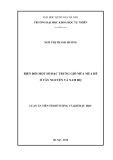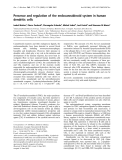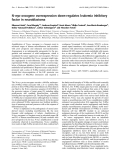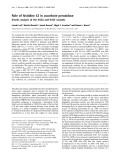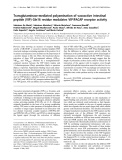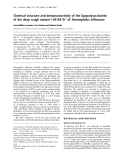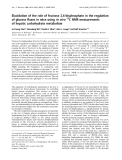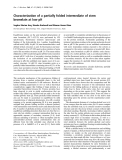
RESEARCH Open Access
Vascular endothelial growth factor regulates
melanoma cell adhesion and growth in the bone
marrow microenvironment via tumor
cyclooxygenase-2
María Valcárcel
1
, Lorea Mendoza
2
, José-Julio Hernández
2
, Teresa Carrascal
2
, Clarisa Salado
1
, Olatz Crende
2
and
Fernando Vidal-Vanaclocha
3*
Abstract
Background: Human melanoma frequently colonizes bone marrow (BM) since its earliest stage of systemic
dissemination, prior to clinical metastasis occurrence. However, how melanoma cell adhesion and proliferation
mechanisms are regulated within bone marrow stromal cell (BMSC) microenvironment remain unclear. Consistent
with the prometastatic role of inflammatory and angiogenic factors, several studies have reported elevated levels
of cyclooxygenase-2 (COX-2) in melanoma although its pathogenic role in bone marrow melanoma metastasis is
unknown.
Methods: Herein we analyzed the effect of cyclooxygenase-2 (COX-2) inhibitor celecoxib in a model of generalized
BM dissemination of left cardiac ventricle-injected B16 melanoma (B16M) cells into healthy and bacterial endotoxin
lipopolysaccharide (LPS)-pretreated mice to induce inflammation. In addition, B16M and human A375 melanoma
(A375M) cells were exposed to conditioned media from basal and LPS-treated primary cultured murine and human
BMSCs, and the contribution of COX-2 to the adhesion and proliferation of melanoma cells was also studied.
Results: Mice given one single intravenous injection of LPS 6 hour prior to cancer cells significantly increased
B16M metastasis in BM compared to untreated mice; however, administration of oral celecoxib reduced BM
metastasis incidence and volume in healthy mice, and almost completely abrogated LPS-dependent melanoma
metastases. In vitro, untreated and LPS-treated murine and human BMSC-conditioned medium (CM) increased
VCAM-1-dependent BMSC adherence and proliferation of B16M and A375M cells, respectively, as compared to
basal medium-treated melanoma cells. Addition of celecoxib to both B16M and A375M cells abolished adhesion
and proliferation increments induced by BMSC-CM. TNFaand VEGF secretion increased in the supernatant of LPS-
treated BMSCs; however, anti-VEGF neutralizing antibodies added to B16M and A375M cells prior to LPS-treated
BMSC-CM resulted in a complete abrogation of both adhesion- and proliferation-stimulating effect of BMSC on
melanoma cells. Conversely, recombinant VEGF increased adherence to BMSC and proliferation of both B16M and
A375M cells, compared to basal medium-treated cells, while addition of celecoxib neutralized VEGF effects on
melanoma. Recombinant TNFainduced B16M production of VEGF via COX-2-dependent mechanism. Moreover,
exogenous PGE2 also increased B16M cell adhesion to immobilized recombinant VCAM-1.
Conclusions: We demonstrate the contribution of VEGF-induced tumor COX-2 to the regulation of adhesion- and
proliferation-stimulating effects of TNFa, from endotoxin-activated bone marrow stromal cells, on VLA-4-expressing
* Correspondence: fernando.vidalvanaclocha@ceu.es
3
CEU-San Pablo University School of Medicine and Hospital of Madrid
Scientific Foundation, Institute of Applied Molecular Medicine (IMMA),
Madrid, Spain
Full list of author information is available at the end of the article
Valcárcel et al.Journal of Translational Medicine 2011, 9:142
http://www.translational-medicine.com/content/9/1/142
© 2011 Valcárcel et al; licensee BioMed Central Ltd. This is an Open Access article distributed under the terms of the Creative
Commons Attribution License (http://creativecommons.org/licenses/by/2.0), which permits unrestricted use, distribution, and
reproduction in any medium, provided the original work is properly cited.

melanoma cells. These data suggest COX-2 neutralization as a potential anti-metastatic therapy in melanoma
patients at high risk of systemic and bone dissemination due to intercurrent infectious and inflammatory diseases.
Introduction
A significant proportion of cancer patients with no clini-
cal evidence of systemic dissemination will develop
recurrent disease after primary tumor therapy because
they already had a subclinical systemic spread of the dis-
ease [1]. Bone marrow (BM) is a common site of occult
trafficking, infiltration and growth of blood-borne cancer
cells, and their metastases are a major cause of morbid-
ity [2]. Not surprisingly, circulating cancer cells infiltrate
BM tissue and interact with hematopoietic microenvir-
onment at early stages of progression for most of cancer
types [3]. Subsequent invasion and growth of metastatic
cells at bony sites appear to be facilitated by TGFb[4]
and hematopoietic growth factors [5,6], tumor-asso-
ciated angiogenesis [7,8] and bone remodeling [9]. Thus,
the understanding of complex interactions between can-
cer and bone cells/bone marrow stromal cells leading to
these prometastatic events is critical for the design of an
organ-specific therapy of bone metastasis.
The BM colonization of metastatic tumors, both of
epithelial and non-epithelial origins, is promoted by
inflammation [6,10]. Proinflammatory cytokines released
by cancer cells [11] and tumor-activated BM stromal
cells [12] increase cancer cell adhesion to bone cells
[13] and bone resorption [14,15]. In addition, PGE2
induces VEGF [16] and osteoclast formation [17] in pre-
clinical models of bone-metastasizing carcinomas, sug-
gesting that inflammation can lead to tumor-associated
angiogenesis and osteolysis with the involvement of
cyclooxygenase-2 (COX-2)-dependent mechanism. Inter-
estingly, COX-2 gene is constitutively overexpressed by
most of human epithelium-derived malignant tumors
and plays a role in their growth [18-20] and metastases
[21]. Human melanoma, a non-epithelial tumor charac-
terized by a marked inflammatory stromal response and
osteolytic metastases, also overexpresses COX-2 gene
[22], which may be correlated with the development and
progression of disease [23]. Moreover, as shown by
immunohistochemistry, COX-2 expression in primary
melanomas is restricted to melanoma cells and signifi-
cant correlation between immunohistochemical staining,
tumor thickness and disease-specific survival has been
reported [24], suggesting that COX-2 is a prognostic
marker and a potential therapeutic target, although its
role in the complex pathogenic process of bone metasta-
sis is unclear [3].
In the present study, we analyzed the effect of a selec-
tive COX-2 inhibitor celecoxib –a 1,5 diarylpyrazole
with >300-fold selectivity for COX-2 versus COX-1
[25]–in a model of generalized BM dissemination of
left cardiac ventricle-injected B16 melanoma (B16M)
cells [26] into healthy and LPS-pretreated mice, to
mimic the prometastatic effects of systemic inflamma-
tion [26-29]. Next, we studied the role of COX-2 in the
regulation of murine B16 and human A375 melanoma
cell adhesion and proliferation in response to primary
cultured murine and human BM stromal cell (BMSC)-
conditioned media (CM) in vitro. Furthermore, the spe-
cific effect of exogenous and endogenous BMSC-derived
VEGF as mediator of COX-2-dependent melanoma cell
adhesion and proliferation was also evaluated in vitro.
Our data demonstrate the remarkable contribution of
tumor COX-2 to the regulation of melanoma cell adhe-
sion to BMSCs and proliferation in response to BMSC-
derived VEGF, and suggest anti-metastatic effects of
neutralizing COX-2 in melanoma patients at high risk
of bone dissemination.
Materials and methods
Drugs
SC-58635 (celecoxib) was provided by Richard A. Marks
(Manager, Discovery Res. Adm., GD Searle & Co, Sko-
kie, IL). In addition, Lab Control 1/2 (non-irradiated)
Rodent Chao at 1600 PPM and Mod Cert Rodent w/o
16% celecoxib were also provided by GD Searle & Co,
Skokie, IL.
Animals
Syngeneic C57BL/6J mice (male, 6-8 weeks old) were
obtained from IFFA Credo (L’Arbreole, France). Animal
housing, their care and experimental conditions were
conducted in conformity with institutional guidelines
that are in compliance with the relevant national and
international laws and policies (EEC Council Directive
86/609, OJ L 358. 1, Dec. 12, 1987, and NIH guide for
the care and use of laboratory animals. NIH publication
85-23, 1985).
Culture of Cancer Cells
Murine B16 melanoma (B16M) cells from the B16F10
subline, and human A375 melanoma (A375M) cell lines
were obtained from ATCC (Manassas, VA) and utilized
in the present study. Both cell lines were cultured in
endotoxin-free Dulbecco’s modified Eagle’smedium
supplemented with 10% FCS and penicillin-streptomy-
cin, all from Sigma-Aldridch (St Louis, MO). Cultures
were maintained and passaged as previously described
[29].
Valcárcel et al.Journal of Translational Medicine 2011, 9:142
http://www.translational-medicine.com/content/9/1/142
Page 2 of 14

Systemic Dissemination of Cancer Cells via Left-Cardiac
Ventricle Injection
Mice (10 per experimental group; experiments per-
formed in triplicate) were anesthetized with Nembutal
(50 mg/kg body weight), kept at a warm temperature of
25°C, and the anterior chest wall was shaved and pre-
pared for aseptic surgery by washing with iodine and
70% ethanol. The ribs over the heart were exposed, and
a 30-gauge needle attached to a tuberculin syringe was
inserted through the second intercostal space to the left
of the sternum, into the left ventricle. When blood
entered the tip of the needle, 5 × 10
4
viable cancer cells
in 50 μL HEPES-buffered DMEM were injected. The
needle was withdrawn slowly, and the muscle and skin
were closed with a single suture. Mice received one sin-
gle intravenous injection of 0.5 mg/kg bacterial endo-
toxin lipopolysaccharide (LPS, E. coli, serotype O127:B8)
or vehicle, 6 h before left cardiac ventricle injection of
B16M cells. Then, they were treated with vehicle or cel-
ecoxib until being killed on the 15
th
day postinjection.
Celecoxib was supplied daily in the diet at a dose of 500
mg/Kg along all the assays. The following animal groups
(120 mice) were used: (a) Vehicle-treated normal mice
(10 mice × 3 experiments); (b) Celecoxib-treated normal
mice (10 mice × 3 experiments); (c) Vehicle-treated
LPS-injected mice (10 mice × 3 experiments); and (d)
Celecoxib-treated LPS-injected mice (10 mice × 3
experiments).
Bone Marrow Metastasis Quantitation
The skeletal system of each mouse was completely dis-
sected. The number of metastatic nodules was recorded
under a dissecting microscope (magnification, 10 ×) for
each of the following bones: spine (cervical, thoracic,
lumbar, and sacral bones), skull (maxilla, mandible, and
cranium), thorax (sternum, ribs, and scapula), pelvis
(ilium, ischium, and pubis), foreleg (humerus and
radius) and hindleg (tibia and femur). On the basis of
this inspection, each bone was scored as either contain-
ing a metastatic nodule or being free of microscopic
tumor. The percentage of bones positive for metastasis
was calculated for the total number of mice in each
group (metastasis incidence). In addition, metastasis
volume was estimated for each bone segment at the
time of mouse death. To accomplish this, bones were
directly observed under a video-camera zoom (magnifi-
cation, 10 ×), and the highly contrasted images of bone
segments were digitalized. Then, a densitometric pro-
gram was used to discriminate the black tissue (melano-
tic metastases) from normal bone tissue and to calculate
the percentage of the bone image occupied by metas-
tases. The metastasis volume was then obtained for each
bone segment as follows: the number of recorded
metastases per bone segment (maximum of 10) was
multiplied by the average percentage of surface occupied
by metastasis per bone segment (maximum of 100%)
and expressed as a relative percentage with respect to a
previously defined maximum for each individual bone
segment. To avoid subjective influences on the study of
metastases, the recordings were made in a blind fashion.
Paired and multiple bones were considered as single
bone site with the calculated incidence and metastasis
development indices including both or all of the bones,
respectively, within an animal. Finally, metastasis inci-
dence and volume in LPS-treated mice were expressed
as mean increase percentages with respect to control
mice and in the case of celecoxib-treated mice, results
were expressed as metastasis incidence and volume inhi-
bition percentages with respect to either untreated mice
or LPS-treated animals fed with control chow.
Murine and Human BMSC Isolation, Culture and
Characterization
For murine BMSC isolation, femurs and tibias were
removed and perfused with 10 ml DMEM. The BMSC-
rich effluent was transferred into 25 cm
2
culture flasks
and maintained for two days at 37°C in a humidified
atmosphere with 5% CO2. Once murine BMSCs had
spread out on the culture substrate, the culture medium
was exchanged and supplemented with 20% horse
serum and 200 μg/ml endothelial cell growth factor sup-
plement (ECGS, from Sigma-Aldridch, St Louis, MO), as
previously described [30].
For human BMSC isolation, bone marrow aspirates
were obtained from patients undergoing bone marrow
harvest for autologous bone marrow transplantation,
after informed consent. The BM aspirate was immedi-
ately diluted in 1:1 in Hanks’balanced salt solution
(HBSS) containing 1 Mmol/L EDTA, and passed
through a 40-μm stainless steel filter to remove
loosely attached hematopoietic cells. The filter was
then placed in a 50 ml conical tube and retained stro-
mal elements were resuspended in 5 ml HBSS, fol-
lowed by the addition of 0.1% collagenase
(Worthington Biochem. Co., Lakewood, NC) for 30
min at 37°C. The digested material was filtered
through a nylon gauze and centrifuged at 200 gfor 5
min at room temperature. Then, cells were cultured
in 75-cm2 plastic culture flasks in a concentration of
1×10
6
cells per ml of medium containing alpha-
minimum essential medium (GIBCO, Life Technolo-
gies, Gaithersburg, MD), 12.5% fetal calf serum (FCS,
GIBCO), 12.5% horse serum (GIBCO), 200 μg/ml
ECGS, 10-3 M, hydrocortisone sodium succinate
(Sigma), 10-2 M beta-mercaptoethanol (Sigma), 10
μg/ml gentamicine and 10 μg/ml penicillin-streptomy-
cin (Sigma). Cultured were maintained in a humid
atmosphere at 37°C and 5% CO2.
Valcárcel et al.Journal of Translational Medicine 2011, 9:142
http://www.translational-medicine.com/content/9/1/142
Page 3 of 14

Murine and human BMSCs were characterized on the
7
th
or 15
th
day of primary culture, respectively. To iden-
tify reticular and endothelial cell phenotypes, BMSCs
were incubated with 10 μg/ml Dil-Ac-LDL (Biomedical
Technologies, Inc., Stoughton, MA) for 6 h and with 1
×10
7
FITC-conjugated latex particles/ml (Polysciences,
Warrington, PA) for one additional hour. Under fluores-
cence, light and phase-contrast microscopy, the number
of single and double-labeled BMSCs was recorded in
randomly chosen microscopic fields (n = 20) at a magni-
fication of × 400. LDL endocytotic BMSCs, which did
not take up latex particles (non-phagocytotic), were con-
sidered as endothelial cells, while double-labeled cells
were considered as phagocytotic reticular cells. Other
BMSCs were resuspended, fixed in cold 70% methanol
for 30 min, washed and incubated with anti-human von
Willebrand factor antibody (Serotec Ltd., Oxford, Eng-
land) diluted 1:100 in PBS-1% BSA for 30 min at room
temperature; BMSCs were then washed and incubated
with a FITC-conjugated rabbit anti-mouse IgG anti-
serum (1:10 diluted in PBS-1% BSA) for 30 min at room
temperature. Omission of the primary antibody was
used as control of non-specific binding of the secondary
antibody.
Once BMSCs had been characterized, they were resus-
pended and replated at 1 × 10
6
cells/well/ml in 24-well
plates. Murine and human BMSC conditioned media
(BMSC-CM) were prepared as follows: cultured BMSCs
were incubated for 30 min with basal medium or 1 ng/
ml LPS. Then, cells were washed and incubated with
serum-free medium for additional 6 h and supernatants
were collected, centrifuged at 1,000 gfor 10 min, 0.22
μm-filtrated and used undiluted to treat B16M or
A375M cells.
Cancer Cell Adhesion Assay to Primary Cultured BMSCs
Murine and human BMSCs were cultured for 15 days
prior to be used in adhesion assays. B16M and A375M
cells were labeled with 2’,7’-bis-(2-carboxyethyl)-5,6-car-
boxyfluorescein-acetoxymethylester (BCECF-AM) solu-
tion (Molecular Probes, Eugene, OR). Next, 2 × 10
5
cancer cells/well were added to 24-well-plate cultured
BMSCs and 10 min later, wells were washed three times
with fresh medium. The number of adhering cancer
cells was determined using a quantitative method based
on a previously described fluorescence measurement
system [29]. In some experiments, cancer cells were
incubated for 4 h with 6 h-untreated or LPS-treated
murine or human BMSC-CM before their addition to
BM stromal cells. Some murine BMSC-CM were pre-
incubated with 10 μg/ml anti-murine VCAM-1 mono-
clonal antibodies (R&D Systems, Minneapolis, MN) at
37°C for 30 min before their addition to cancer cells.
For celecoxib-treated groups, 1 μg/ml celecoxib was
added to cancer cells 30 min prior to basal medium
(DMEM), BMSC-CMs, 10 ng/ml recombinant murine
or human VEGF (R&D Systems, Minneapolis, MN) or
100 ng/ml PGE2 (R&D Systems, Minneapolis, MN).
Cancer Cell Adhesion Assay to Immobilized Recombinant
VCAM-1
Ninety six-well plates were coated with 2 μg/ml recom-
binant human VCAM-1 (R&D Systems, Minneapolis,
MN) at 4°C overnight. Nonspecific binding sites on plas-
tic were blocked by treating the wells with 100 μl of PBS
containing 0.5% BSA for 2 h at room temperature. In
some experiments, B16M cells were incubated with
either basal medium, or two different concentrations of
PGE2, 10 and 100 ng/ml (Sigma Chemicals, St. Louis,
MO) for 2 h, or with 1 μg/ml celecoxib for 30 min
before addition of 100 ng/ml recombinant mouse VEGF
(R&D Systems, Minneapolis, MN). In other experiments,
A375M cells were preincubated with or without 1 μg/ml
celecoxib for 30 min before addition of basal medium, 6
h-untreated or LPS-treated BMSC-CM, and 10 ng/ml
recombinant human VEGF (R&D Systems, Minneapolis,
MN) for other 4 h. Then, B16M or A375M cells were
BCECF-AM-labeled and after washing, they were added
(5 × 10
4
cells/well) to quadruplicate wells. Then, plates
were incubated for 30 min, in the case of B16M cells, or
for 60 min in the case of A375M cells, at 37°C before
unattached cells were removed by washing three times
with fresh medium. The number of adhering cells was
determined using a quantitative method based on a pre-
viously described fluorescence measurement system [29].
Cancer Cell Proliferation Assay
Murine and human BMSC-conditioned media (BMSC-
CM) were added to 2.5 × 10
3
B16M and A375M cells,
respectively, seeded into each well of a 96-well microtiter
plate, in the presence or not of either 1 μg/ml celecoxib or
1μg/ml anti-VEGF monoclonal antibody. Control mela-
noma cells were cultured in the presence of basal medium
(DMEM) used in generating BMSC-CM. In some wells, 10
ng/ml recombinant VEGF was added to melanoma cells in
the presence or not of 1 μg/ml celecoxib. After 48 h incu-
bation, B16M and A375M cell proliferation was measured
using sulforhodamine B protein assay, as previously
described [31]. Each proliferation assay was performed in
cuadruplicate and repeated three times.
Measurement of Cytokine Concentration in murine BMSC
supernatants
TNFaand VEGF concentration were measured in
supernatants from primary cultured BMSC using an
ELISA kit based on specific murine TNFaand VEGF
monoclonal antibodies as suggested by the manufactures
(R&D Systems, Minneapolis, MN).
Valcárcel et al.Journal of Translational Medicine 2011, 9:142
http://www.translational-medicine.com/content/9/1/142
Page 4 of 14

Western Immunoblot Analyses
To study COX-2 expression by cultured B16M, basal
medium-cultured B16M cells were treated or not for 4
h with 10 and 100 ng/ml recombinant murine VEGF.
Then, they were collected in the lysis buffer [300 mM
NaCl, 50 mM HEPES, 8 mM EDTA, 1% NP40, 10% gly-
cerol, 1 mM Na3VO4, 0.1 mM DTT, 10 mM NaF and
protease inhibitor cocktail tablets, as suggested by the
manufacturer (Roche Diagnostics, Mannheim, Ger-
many)]. Same amount of protein from cell lysates were
size-separated on 10% SDS-PAGE gel and transferred
overnight to a nitrocellulose membrane (BioRad,
Laboratories, Hercules, CA). Blots were blocked for 2 h
with 5% non-fat milk and then incubated for 1 h with
rabbit monoclonal antibody against human COX-2
(Oxford Biomedical Research, Rochester Hills, MI)
diluted 1:500 with PBS. Blots were then incubated with
peroxidase conjugate anti-rabbit IgG (Santa Cruz Bio-
technology, Santa Cruz, CA). Bands were visualized
using the Super Signal West Dura Extended Substrate
kit (Pierce, Rockford, IL). Equal protein loading in the
10% SDS-PAGE electrophoresis was confirmed by
immunoblotting for beta-tubulin expression. Bands were
scanned and densitometrically analyzed using the NIH
image analysis program for Macintosh to obtain normal-
ized COX-2/b-tubulin values.
To study VCAM-1 expression by BMSCs, basal med-
ium-cultured cells received or not 1 ng/ml LPS for 6 h.
Then,theywerewashedwithPBSanddisruptedwith
RIPA buffer (50 mM Tris, 150 mM NaCl, 1% NP-40,
0.5% deoxycholic acid, 0.1% sodium dodecyl sulfate, 2
mMEDTA,10mMNaF,10μg/ml leupeptin, 20 μg/ml
aprotinin, a nd 1 mM phenylmethylsulfonylfluoride).
Proteins from cell lysates were immunoprecipitated with
10 μggoatanti-mouseagarose-conjugated VCAM-1
polyclonal antibody (Santa Cruz Biotechnology, Santa
Cruz, CA) and blots were blocked and incubated with
rat anti-mouse VCAM-1 monoclonal antibody (Serotec
Ltd) diluted 1:500 with 5% milk-PBS. Blots were next
incubated with peroxidase conjugatedgoatanti-ratIgG
(Santa Cruz Biotechnology, Santa Cruz, CA). Bands
were visualized using the Super Signal West Dura
Extended Substrate kit (Pierce, Rockford, IL) and were
scanned and densitometrically analyzed using the NIH
image analysis program for Macintosh to obtain normal-
ized VCAM-1/b-tubulin values.
Statistical Analyses
Data were expressed as statistical software for MS win-
dows, release 6.0 (Professional Statistic, Chicago, IL).
Homogeneity of the variance was tested using the
Levene test. If the variances were homogenous, data
were analyzed by using one-way ANOVA test with
Bonferroni’s correction for multiple comparisons when
more than two groups were analyzed.
Results
Inhibition of Melanoma Bone Marrow Metastasis by
Celecoxib
Mice developed a mean number of 35 ± 6 macroscopic
metastases by day 15 after LCV injection of B16M cells.
As previously reported [26], bone was one of the most
frequentsitesofmetastasisinthistumormodel.The
histological examination of bones by day 10 after cancer
cell injection prior to macroscopic development of
metastases, revealed subclinical micrometastases limited
to the hematopoietic tissue of red BM, which indicates
that bone-infiltrating B16M cells specifically colonized
extravascular compartments of BM (Figure 1A and 1B).
Thereafter, macroscopic metastases occurred in the per-
iphery of flat bones and in the metaphysis of long
bones. In addition, metastasis incidence variation among
different bone segments (Figure 1C, D and 1E) made it
possible to define two bone subgroups: 1) Bones with
high metastasis incidence (Table 1), involving the max-
illa, mandible, spine, ribs, ilium, humerus, scapula,
femur, and tibia; and 2) bones with low metastasis inci-
dence (having 50% fewer metastases), comprising the
radius, pubis, ischium, sternum, and cranium.
Mice given 0.5 mg/kg LPS as a single intravenous
injection 6 h prior to B16M cell injection exhibited a
generalized enhancement of bone metastasis, which sig-
nificantly (P< 0.05) raised the number of bony sites
harboring metastases per mouse compared to saline-
treated mice (Figure 2A and 2B). However, this prome-
tastatic effect of endogenous inflammation was also
bone-specific: 1) LPS significantly (all P<0.05)
increased the metastasis incidence and volume in the
maxilla, mandible and scapula; 2) metastasis volume, but
not incidence, significantly (all P< 0.05) increased in the
femur, tibia and spine; 3) metastasis incidence, but not
its volume, significantly (all P< 0.05) increased in the
humerus and ilium; and 4) no significant metastasis
increase was observed in ribs.
Other mice received either control chow or chow con-
taining 16% celecoxib since the time of tumor injection.
Application of this treatment schedule to B16M cell
LCV-injected healthy mice significantly (P<0.01)
reduced the formation of metastases in several bones.
There was a statistically significant (all P<0.05)reduc-
tion of metastasis incidence in the spine, pubis, femur,
tibia, humerus, and radius, whereas the decrease of inci-
dence in maxilla, mandible, ilium, ischium, ribs, scapula
and sternum was not significant in comparison to con-
trol mice (Figure 3A). In addition, the metastasis volume
dropped significantly (all P< 0.05) in most of bones
Valcárcel et al.Journal of Translational Medicine 2011, 9:142
http://www.translational-medicine.com/content/9/1/142
Page 5 of 14

